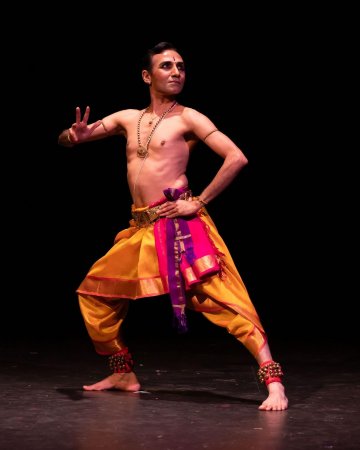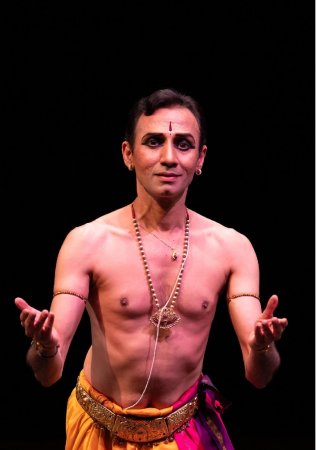
|   |

|   |
Sakha: A dance of friendship - Swathi Ramaprasad e-mail: swathi181@gmail.com Photos: Ravi Shekar Photography September 27, 2024 Devotional themes and relationships are often highlighted in traditional Bharatanatyam pieces. These relationships are sometimes depicted as being literally between a devotee and God, with the devotee's perspective being that of a male or female devotee. Other times, compositions will use romantic relationships as an allegory for devotional ones, with lyrics that seem romantic, but at their core are about a relationship with God. These types of pieces are usually from a female perspective, showing devotion or love for a male deity. Occasionally we see pieces about relationships with a sakhi - a female friend, but pieces about friendships through the male lens are rare.  This perspective was brought to light in Sakha: A Friend, a thematic solo presentation by P. Praveen Kumar, this year's guest artiste at Smaran Dance Festival which took place on September 22, 2024. Smaran Dance Festival is held annually by Smaran Performing Arts, a prominent Bay Area organization, founded and led by Vidyalatha Jeerage. This year, Praveen Kumar received the Smaran Kala Shikara award as a part of the festival's Smaran Awards. Sakha opened with the Aditya Hridaya shloka followed by the popular Tanjore Quartet Ragamalika Jathiswaram in mishra chapu tala. Praveen's creatively choreographed jathis and artistic, athletic execution brought a fresh and unique take to this traditional piece. This served as an exciting opening before the evening's more theme-oriented items. Next was the main item of the presentation, a composition titled 'Sakha' composed specifically for Sakha by Dr. Shatavadhani R. Ganesh in Hindola raga, set to adi tala. The word "sakha" means friend, and fittingly, this item focused on the strong, continuing, and life changing nature of Arjuna's friendship with Krishna from Arjuna's perspective. In this piece, Arjuna recounts and reflects on several key anecdotes from his life where Krishna assisted, protected, or supported him. Included anecdotes were Krishna moving the Govardhana Mountain, Draupadi Swayamwara, Subadra Kalyanam, Krishna imparting the Bhagavad Gita to Arjuna, Krishna's support to Arjuna on the battlefield, and in surrender. The item opened with an exciting jathi depicting Arjuna shooting arrows that effectively weaved storytelling into the excellent, dynamic nritta. Jathis throughout the item continued this trend of using mudras and movement across stage to continue the narrative in-between the verses telling each anecdote. Praveen's expressive abhinaya truly depicted how consequential Krishna's role was in each of these stories, seamlessly transitioning from expositorily telling the story, to emphasizing when and how Krishna assisted Arjuna every time. This was also aided by the excellent orchestration of the music for this piece. Each time Krishna arrived in a story, flute accompaniment (Krishna's signature instrument) would begin in the music, creating a full sound. This was a sensory way to show the feeling of when a friend comes into your life, and you come to realize how necessary they are. The music sounded great throughout the piece, but it sounded complete whenever the flute would come in to underscore Krishna's presence. This helped emphasize just how consequential Krishna's role was in Arjuna's life - while Arjuna depicts how necessary Krishna is in his life, the addition of the flute accompaniment completes the orchestration, providing an impactful effect. This item was memorable because the artful and evocative performance showed both a friendship between man and God, and at the same time, a platonic male friendship. Looking at a relationship with God from the lens of friendship was interesting, because that is not a dynamic seen often. This piece makes the audience reflect on why that is, making them question: can't friendships hold the type of deference, reverence, and love that a devotee has for God? The other way of seeing this relationship, the male platonic friendship, is an important relationship archetype that is relatable and important in many people's lives but is not often shown or analyzed through classical Indian dance. Bharatanatyam and many other classical dance forms are dominated by women both on the stage, and in the audience, and something to think about to change this is curating pieces and performances that can be related to by male audiences, and this piece successfully does that. The creative use of nritta and abhinaya for storytelling, and the intentional use of music in this piece made it the highlight of the night from my perspective.  The next item, 'Viraha Sakha,' a Kshetrayya Padam in Mukhari raga, set to mishra chapu tala, depicted a very different type of relationship. The word "viraha" describes a love found through separation, revealed through the unexpected suffering in the absence of a friend. As this piece was being introduced, there was an audible gasp in the audience, as the relationship it focused on was one between a man who left his wife and family for another woman and the other woman who then leaves him for another man. The consensus in the audience was that he got what was coming for him. Another gasp ensued when it was revealed that the narrator, now reflecting on his love for his family, and this other woman, believed that all that was left for him to do was to go to Kashi to wash away his sins to his family (a euphemism to say that he was ready to die as a result of his mistakes). This item opened with a sanchari that depicts the narrator before the relationship fails, where he appears happy and carefree, and once the lyrics begin, the narrator relays his woes and regrets in hindsight, reflecting on the consequences of his actions. While the narrator in this piece is not a sympathetic character, and in real life most of us would likely feel like this was karma, Praveen's expressions depicting remorse and wistful reflection in this piece really evoke a feeling of pity and borderline sympathy from the audience, which is a testament to the abhinaya of the performance. This failed friendship was an interesting relationship to see through the medium of Bharatanatyam dance. While the details of this relationship probably do not apply to most (hopefully), a lot of people do experience friendships that go sour, or end on bad terms. Similarly, people may look back nostalgically on these relationships but can still know that they must live with the fact that the friendship is over. These emotions are very real and relatable, and making classical arts relatable is a crucial step to make them more popular and understood among modern audiences. The last piece from this presentation was 'Pranaya Sakha' in Kanada raga and adi tala, a composition of Mysore Vasudevacharya. The word "pranaya" refers to love, and this piece depicted a friendship forged through love. Krishna was the narrator in this piece, and the friendship was one with a Gopika who had become unexpectedly cross with him. In this piece, Krishna tries various strategies, and methods to win back the favor of his friend. In this piece, Praveen showed the more playful and charming emotions of Krishna, resulting in a piece that kept the audience on the edge of their seats to see which antic will ultimately win back his friend's favor, culminating in a shared feeling of victory when the Gopika finally forgives and forgets, and resumes the friendship as the piece concluded. The relationship shown in this piece is relatable for audiences, because most people have small tiffs or spats with even the best of their friends, that ultimately are easy to resolve and repair, and often strengthen the friendship in the long term. Also relatable, is the dynamic of a person being proverbially upset with God. Crisis of faith, and anger at God happens to people at different points of life, but as in this piece, eventually the anger or crisis dissipates, and the relationship is restored. This piece showed a thoughtful story in a joyous way that made it very enjoyable for the audience. Through the presentation of Sakha, P. Praveen Kumar blended strong and athletic nritta, with evocative abhinaya, and intentionally arranged music to share stories from unique and original perspectives. The range of emotions and relationships depicted throughout Sakha was vast, starting with the friendship informed by deference that Arjuna has with Krishna in 'Sakha,' followed by the sorrowful emotions and tumultuous relationships shown in 'Viraha Sakha', concluding with a playful narrative of Krishna restoring a friendship through his charming antics in 'Pranaya Sakha'. It is safe to say, Sakha took the audience on an emotional rollercoaster in the best possible way.  Swathi Ramaprasad is a senior student of Bharatanatyam dance and Carnatic music. Having completed her arangetram in both art forms, she continues to perform when possible, and regularly attends live music and dance shows and appreciates them through both a modern and traditional lens. Swathi is a graduate of the University of California, Berkeley and now lives and works in the Bay Area. |